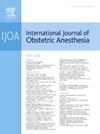Extracorporeal membrane oxygenation (ECMO) in pregnancy and peripartum: a focused review
IF 2.6
3区 医学
Q2 ANESTHESIOLOGY
引用次数: 0
Abstract
As the medical complexity of pregnant patients increases, the rate of maternal morbidity has risen. Maternal cardiovascular disease is a leading cause of maternal morbidity and mortality followed closely by sepsis and infection, both of which may be associated with respiratory failure. There has been an expansion in the application of extracorporeal life support in pregnant and peripartum patients which requires obstetric anesthesiologists to understand the indications, obstetric and medical considerations, relative advantages and potential complications of this invasive technology in this population. Obstetricians and anesthesiologists who care for women on the labor floor must strive to recognize at-risk and deteriorating patients, facilitate escalation of care when appropriate, and engage consultant teams to consider the need for extracorporeal support in high-risk circumstances. This article reviews the epidemiology, indications, specific considerations, potential complications, and outcomes of extracorporeal life support in pregnant and peripartum patients.
妊娠和围产期体外膜肺氧合(ECMO):重点综述。
随着孕妇医疗复杂程度的增加,孕产妇发病率也在上升。孕产妇心血管疾病是孕产妇发病和死亡的主要原因,其次是败血症和感染,这两种疾病都可能与呼吸衰竭有关。体外生命支持在孕妇和围产期病人中的应用不断扩大,这就要求产科麻醉师了解这一侵入性技术在这一人群中的适应症、产科和医学考虑因素、相对优势和潜在并发症。在产房护理产妇的产科医生和麻醉医生必须努力识别高风险和病情恶化的患者,在适当的时候促进护理升级,并让顾问团队考虑在高风险情况下是否需要体外支持。本文回顾了妊娠和围产期患者体外生命支持的流行病学、适应症、具体注意事项、潜在并发症和结果。
本文章由计算机程序翻译,如有差异,请以英文原文为准。
求助全文
约1分钟内获得全文
求助全文
来源期刊
CiteScore
4.70
自引率
7.10%
发文量
285
审稿时长
58 days
期刊介绍:
The International Journal of Obstetric Anesthesia is the only journal publishing original articles devoted exclusively to obstetric anesthesia and bringing together all three of its principal components; anesthesia care for operative delivery and the perioperative period, pain relief in labour and care of the critically ill obstetric patient.
• Original research (both clinical and laboratory), short reports and case reports will be considered.
• The journal also publishes invited review articles and debates on topical and controversial subjects in the area of obstetric anesthesia.
• Articles on related topics such as perinatal physiology and pharmacology and all subjects of importance to obstetric anaesthetists/anesthesiologists are also welcome.
The journal is peer-reviewed by international experts. Scholarship is stressed to include the focus on discovery, application of knowledge across fields, and informing the medical community. Through the peer-review process, we hope to attest to the quality of scholarships and guide the Journal to extend and transform knowledge in this important and expanding area.

 求助内容:
求助内容: 应助结果提醒方式:
应助结果提醒方式:


